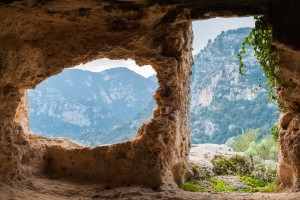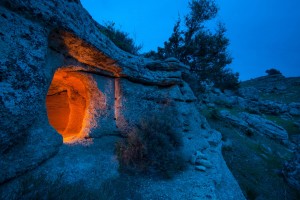
©Bigstock.com/siculodoc
Did you know that parts of Sicily were populated as early as the Bronze Age? The settlement history of the island in the southernmost part of Italy can be traced back thousands, even tens of thousands of years. Even today you can retrace the historical steps of cultures long gone thanks to old monuments and ruins with an almost mythical touch. A particularly attractive compilation of ancient and antique documents was included on the list of UNESCO World Heritage Sites in 2005. Syracuse and the Rocky Necropolis of Pantalica consists of three separate parts with a total area of nearly 900 ha plus a buffer zone almost six-times that. Join us on a tour of the very, very old Sicily!
Why is this site so important and worthy of protection?
When choosing new sites worthy of protection during its conferences, the UNESCO World Heritage Committee usually lists several criteria. Syracuse and the Rocky Necropolis of Pantalica first and foremost are named a remarkable testimony of Mediterranean culture where prehistoric settlements, Greek colonisation, brief Punic influence and, finally, Roman conquests come together. Don’t sleep on the cultural variety of the combined site spanning across three millennia. After all, the ruins throughout Syracuse and Ortygia exemplify how several cultural concepts from Greek and Roman beginnings to modern baroque aspects advanced architecture from all angles. The ancient significance of the city, even if it’s “only” for being the home of Archimedes, is another key factor.
Necropolis of Pantalica

©Bigstock.com/siculodoc
But first, we start about 35 km west of Syracuse in the small town Sortino. Several churches with stunning frescoes dominate its centre, but things get even more exciting once we reach the outskirts. They are home of the Rocky Necropolis of Pantalica, one of the largest necropolises in all of Sicily. It is located in the former settlement Pantalica, the namesake of the so-called Pantalica culture which left its mark on the island in the late Bronze Age and early Iron Age. The sheer size of the burial ground with over 5,000 chambered tombs suggests a very long-term use with actual finds dating the utilisation to a time between the 13th and 8th century BC. Greek colonisation would eventually cause the decline of the settlement. While the tombs were used as dwellings in early Christian times, hardly anything survived of Pantalica itself.
Tour the area with a guide to gain access to all areas of the necropolis and to learn everything about Pantalica’s exciting history. Five tomb areas retrace the evolution of burial rites. It wasn’t only the openings to the various chambered tombs that changed over the course of time. Climbing the hill of the old settlement, you’ll discover the anaktoron. The structure of this former princely palace is at least partially visible to the naked eye. Many other finds from the settlement and the rocky necropolis, such as ceramics, weapons and household articles, are currently on display at the Archaeological Museum of Syracuse.
Ortygia
Syracuse wasn’t actually founded on the mainland, but rather on a small island separated from the rest of the city by just a small channel. First testimonies of human settlement on Ortygia even date back to the Neolithic Age followed by several finds from the early and mid-Bronze Age. Syracuse’s history effectively begins in 734 BC when Doric settlers from Corinth founded the city on Ortygia before quickly extending it onto the mainland. The ideal location had Syracuse quickly rise to becoming the biggest and most important polis of old Sicily. Roman troops only managed to conquer the city during the second Punic War, thereby kicking off an architectural blending on both the island and the mainland. Severe destructions after a major earthquake in 1693 led to reconstructions in a more baroque style. That’s why you’re met by this truly special architectural plurality in Syracuse.
Ortygia served as the city core in ancient times. As such, there’s a plethora of old buildings and ruins for you to see, such as:
- Temple of Apollo: Built in the early 6th century BC, research believes it to be the oldest larger Sicilian temple. It’s situated at the entrance to the historic city centre and suggests several conversions into Christian churches and Arab mosques in later times.
- Porta Urbica: Fragments of this city gate erected at the end of the 5th century BC are the only thing remaining of the island’s city walls. Dionysius I had it built as protection against the Carthaginians. The gate likely connected the Temple of Apollo to the Temple of Athena that would eventually become the…
- Cathedral of Syracuse: Also known as Santa Maria delle Colonne, it used to be the site of the aforementioned Temple of Athena. Instead of tearing down the entire Doric temple when construction of a Christian basilica commenced in the 7th century AD, parts of it were incorporated into the new building. Partial pillars are still visible from the outside and the inside. Some bricks and stalactites are exhibited in the Archaeological Museum.
- Castello Maniace: Unlike many other buildings, this impressive fortress was only constructed in medieval times. Various stylistic elements, such as the Stauffer portal, the Gothic portico and the modern Stauffer stele, attest to this structure’s unusual history.
Ancient sites of Syracuse
Finally, we leave the island and head into the city itself. Discover ruins of monuments from very different eras throughout Syracuse. Don’t miss out on the following ancient sites:
- Parco Archeologico della Neapoli: Founded in the early 1950s, the archaeological park of Syracuse encompasses the major ancient structures of the mainland. The craggy shapes of the more than ten old quarries, the so-called latomie, will put you under their spell, while the ruins of Hiero’s Ara make the rush of history palpable. A Greek theatre and a Roman amphitheatre are also part of this vast area. Don’t miss out on the fascinating Ear of Dionysius.
- The sanctuaries: Ruins and fragments of several sanctuaries are hidden throughout the city. The ancient neighbourhood south of the church Madonna delle Lacrime unearthed the Sanctuary of Demeter and Kore from ancient Greece. Sadly, this part currently isn’t open to the public due to further archaeological evaluations.
- Castello Eurialo: The fortification of Dionysius I was situated at the highest point of the ancient city, now located approx. seven kilometres outside modern Syracuse. Originally planned as the corner point of the northern and western city walls, it was connected to various districts by secret passages and could harbour up to 3,000 soldiers and 400 horsemen. The surviving ruins display Byzantine conversions of later periods.
We could go on like this forever as your tour through this unique UNESCO World Heritage Site is easily extended at will. You could easily spend a second or even a third day in Syracuse and Ortygia alone, not even including the amazing rocky necropolis. It’s now or never for your holiday on Sicily!